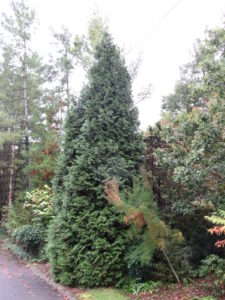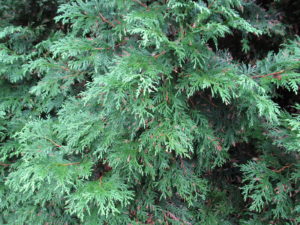Western red cedar or giant red cedar (Thuja plicata) is native to the Pacific Northwest. In the eastern U.S. it is called western arborvitae and landscapers typically do not plant it. Instead, they plant the hybrid cultivar ‘Green Giant’ arborvitae, a cross between western red cedar (T. plicata and Japanese arborvitae (T. standishii).
Western arborvitae is typically found in cool moist forest areas and bottomlands from southern Alaska along the Pacific coastline to northern California and from British Columbia to western Montana (USDA hardiness zones 5-7).
Western arborvitae is the largest tree in the cypress family, averaging 100 feet and more in height and long-lived from 400 to 1000 years in the Pacific Northwest. However, east of the Mississippi River, expect dimensions 50-60 feet high and 15-25 feet wide at its base. It features horizontal branching with sprays of scale-like dark green foliage which is aromatic when crushed. Flowers are inconspicuous and small, half-inch long light brown cones follow and mature in fall.
Cultivar ‘Green Giant’ grows even faster into a large 50 – 60 feet vertical specimen tree. It is widely planted as a tall privacy hedge or screen. Screen grows to 50-feet in height and spread of 15 to 20 feet at its base. Young ‘Green Giant’ transplants grow 2- 3 feet annually if planting is adequately fertilized and irrigated. Summer needles are bright green and retain its green color through the winter, far better than Japanese cedar (Cryptomeria japonica) and Leyland cypress (x Cupressocyparis leylandii).
Western arborvitae grows best in moist, humus-rich, well-drained soils in full sun to partial shade. It thrives where summers are moist and cool. One year old established plants exhibit good drought tolerance, more so with age.
Western arborvitae exhibits no serious disease or insect problems. Bagworms may become serious pests. Root rots may occur if soil drainage is poor.
Currently, Green Giant arborvitae is replacing Leyland cypress as landscape privacy screening. Leyland cypress has proven susceptible to 3 serious disease problems in the southeastern U.S. Low growing shrub forms of western arborvitae are also available.



 Posted in
Posted in 
